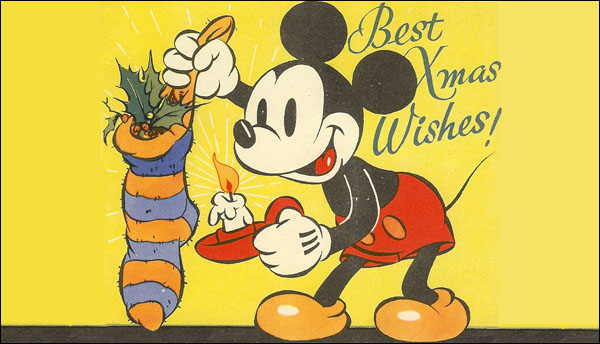
Suspended Animation #298

People usually do not realize how bold it was for Walt to make theatrical cartoons themed to Christmas.
The tight theatrical window of opportunity in which such a cartoon might be exhibited and limited global market where the holiday was celebrated differently or not at all coupled with the company’s enormous reliance on revenue from animation to stay afloat in those pre-Disneyland years, made every Christmas cartoon a financial gamble.
The real fear was that distributors would severely limit the availability of a cartoon with a Christmas theme. At one point, Walt Disney considered a Christmas scene in the animated feature Pinocchio (1940) which would have taken advantage of a snowy Alpine village in a winter setting with Gepetto’s mechanical toys and emphasizing the importance of being rewarded for being “good” throughout the year by not lying.
From a January 6th, 1938 story meeting, Walt Disney said, “That’s the trouble – the exhibitors will class it as a Christmas picture and only run it at Christmas time. Well, Heidi had Christmas in it – they had quite a sequence there of Christmas… Still, we don’t need it. It doesn’t matter. We were just trying to get something pictorial in here.”
 The Christmas oriented cartoons could not really be re-released during the rest of the year and some countries like Japan and China did not celebrate Christmas and other countries celebrated it much differently than in the United States. An example is the “Las Posadas” sequence featured in the film The Three Caballeros (1944) showing a Christmas tradition among Mexican children generally unknown to most Americans.
The Christmas oriented cartoons could not really be re-released during the rest of the year and some countries like Japan and China did not celebrate Christmas and other countries celebrated it much differently than in the United States. An example is the “Las Posadas” sequence featured in the film The Three Caballeros (1944) showing a Christmas tradition among Mexican children generally unknown to most Americans.
I love Christmas and I love Mickey Mouse so here is a listing of just some of the popular Disney theatrical Christmas cartoons produced while Walt Disney was alive:
Mickey’s Orphans (1931): A basket of orphan kittens are left on Mickey’s doorstep at Christmas. Mickey dresses up as Santa, with Pluto attired as a reindeer. The kittens proceed to use their toys to destroy the house and decimate the candy cane-filled Christmas tree.
This short was nominated for an Oscar but lost to another Disney nominee, Flowers and Trees, the first cartoon short in Technicolor. Mickey’s Orphans was inspired by Walt’s Oswald the Rabbit cartoon Empty Socks (1927), in which Oswald dresses as Santa and fills the empty Christmas stockings hung by the chimney at an orphanage.
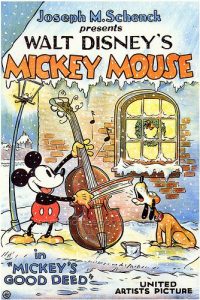 Mickey’s Good Deed (1932): On Christmas Eve, Mickey and Pluto are street performers in dire straits. Mickey has to sell Pluto to a rich family to get money to help out a poor single mother’s large family (another group of poor cat children). The bratty kid who wanted Pluto tortures the poor pup and the father finally releases the dog when he sees what is going on. Mickey and Pluto are reunited happily but still poor at the end.
Mickey’s Good Deed (1932): On Christmas Eve, Mickey and Pluto are street performers in dire straits. Mickey has to sell Pluto to a rich family to get money to help out a poor single mother’s large family (another group of poor cat children). The bratty kid who wanted Pluto tortures the poor pup and the father finally releases the dog when he sees what is going on. Mickey and Pluto are reunited happily but still poor at the end.
The short’s release during the Great Depression made its story matter particularly poignant. Pinto (Goofy) Colvig supplied the voice for the little brat’s rich father. The concept of down-on-their-luck street musicians who get their instruments crushed in the snow may have been inspired by a similar scene from the Laurel and Hardy comedy short Below Zero (1930).
Pluto’s Christmas Tree (1952): Mickey chops down a tree for Christmas, not realizing it houses the chipmunks Chip’n’Dale, and hauls it back into his living room. The unwittingly relocated chipmunks get into mischief in the tree and the living room, thwarting Pluto’s every attempt to stop them.
Goofy, Donald and Minnie appear on the front lawn as carolers and join Mickey and Pluto to sing the carol Deck the Halls, making this one of just three Golden Age theatrical shorts in which the “Fab Five” appear together. The other two cartoons are On Ice (1935) and Hawaiian Holiday (1937). Disney sound-effects legend Jimmy Macdonald voiced both Mickey Mouse and in a sped-up version the chipmunk Chip in this short. Here is its rare original front and end titles:
There is one Donald Duck Christmas cartoon that usually does not immediately come to mind when many people think of Disney Christmas shorts.
Toy Tinkers (1949): Enticed by a house full of nuts, candies, and other Christmas goodies, the chipmunks Chip’n’Dale infiltrate Donald Duck’s home and engage in a war (using an arsenal of toys) with the feisty fowl.
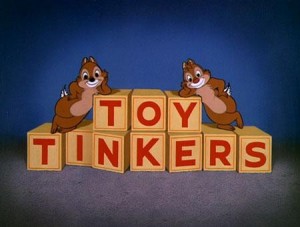 It was nominated for an Oscar but lost to the Chuck Jones directed Pepe Le Pew the skunk animated short For Scent-imental Reasons. A ten page comic book adaptation of the short drawn by Paul Murry was published in Walt Disney’s Christmas Parade #2 (November 1950), printed by Dell Comics.
It was nominated for an Oscar but lost to the Chuck Jones directed Pepe Le Pew the skunk animated short For Scent-imental Reasons. A ten page comic book adaptation of the short drawn by Paul Murry was published in Walt Disney’s Christmas Parade #2 (November 1950), printed by Dell Comics.
Of course some people consider the cartoon The Clock Watcher (1945) as a Christmas-themed cartoon. It has Donald Duck as an overworked and poorly trained gift wrapper at Royal Brothers department store with an especially funny sequence where he struggles to wrap a stubborn jack-in-the-box.
When Disney does a special Christmas cartoon compilation for its shows on television, also included are usually Santa’s Workshop (1932) and The Night Before Christmas (1933) which is sort of a sequel to the first cartoon.
In addition, because of the paucity of actual Christmas cartoons, Disney also often throws in some cartoons that have a wintery theme:
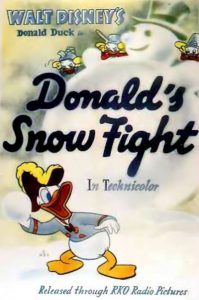 • Corn Chips (1951) has Chip’n’Dale tricked into shoveling the snow from Donald Duck’s sidewalk but they get their revenge and Donald ends up shoveling a ton of popcorn.
• Corn Chips (1951) has Chip’n’Dale tricked into shoveling the snow from Donald Duck’s sidewalk but they get their revenge and Donald ends up shoveling a ton of popcorn.
• Once Upon a Wintertime (1948) originally appeared in the compilation feature Melody Time. With outstanding design work by Mary Blair, two (speechless) young lovers enjoy a December outing in the snow until showing off on the ice triggers a near-tragedy.
• In Donald’s Snow Fight (1942) Donald battles his three nephews in the snow including attacking their snow fortress with his ice battleship.
• On Ice (1935) has Mickey teaching Minnie to ice skate, Goofy ice fishing and Donald teasing Pluto.
A compilation of Disney cartoons featuring some of these shorts was released to theaters in 1953 by RKO entitled Walt Disney’s Christmas Jollities.
It was one of several Disney cartoon compilation films RKO released in 1953 to meet contractual obligations so Disney could start its own film distribution department. Those other compilations included New Year’s Jamboree, 4th of July Firecrackers, Fall Varieties, Halloween Hilarities, Thanksgiving Day Mirthquakes, and Mickey’s Birthday Party.
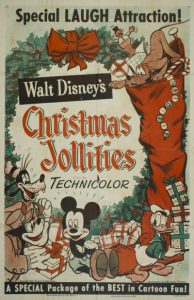 Little is known about what cartoons were included in those compilations although some good guesses might be made. They have never been re-shown.
Little is known about what cartoons were included in those compilations although some good guesses might be made. They have never been re-shown.
Another interesting oddity is that the last package film released during Walt’s lifetime was Music Land (1955) that only played in theaters once and was never released on home video. This film should not be confused with the 1935 Disney animated short titled Music Land that has no connection with this feature at all.
The Disney Company had created its own distribution company, Buena Vista Distribution, but still owed its former distribution company, RKO, one more release under its contract.
So, Disney took four segments from Make Mine Music and five from Melody Time. “The Big Parade of Mirth and Melody!” was released October 5, 1955, and never shown again except for a 1970 “Tribute to Walt Disney” retrospective at the National Film Theater.
The segments in this feature were “Trees,” “All the Cats Join In,” “After You’ve Gone,” “Once Upon a Wintertime,” “Pecos Bill,” “Johnny Fedora and Alice Blue Bonnet,” “Bumble Boogie,” “Casey at the Bat” and “Blame It on the Samba.”
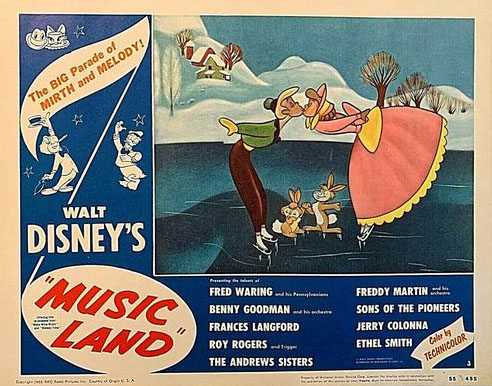


 Jim Korkis is an internationally respected animation historian who in recent years has devoted his attention to the many worlds of Disney. He was a columnist for a variety of animation magazines. With his former writing partner, John Cawley, he authored several animation related books including The Encyclopedia of Cartoon Superstars, How to Create Animation, Cartoon Confidential and Get Animated’s Animation Art Buyer’s Guide. He taught animation classes at the Disney Institute in Florida as well as instructing classes on acting and animation history for Disney Feature Animation: Florida.
Jim Korkis is an internationally respected animation historian who in recent years has devoted his attention to the many worlds of Disney. He was a columnist for a variety of animation magazines. With his former writing partner, John Cawley, he authored several animation related books including The Encyclopedia of Cartoon Superstars, How to Create Animation, Cartoon Confidential and Get Animated’s Animation Art Buyer’s Guide. He taught animation classes at the Disney Institute in Florida as well as instructing classes on acting and animation history for Disney Feature Animation: Florida.




















































“Mickey’s Orphans” has a lot in common with the Alice Comedy, “Alice’s Orphan” (1926), although the latter is not a Christmas cartoon per se. On a snowy night in midwinter, a shadowy figure abandons a basket containing a kitten (just one). Julius the cat brings it into Alice’s home, and he feeds and bathes it, but the kitten turns out to be nothing but trouble. In the end, Julius conks the little guy over the head with a mallet just to get him to fall asleep. Modern child-rearing manuals strongly disapprove of this.
I realise this post deals with Christmas cartoons produced during Walt’s lifetime, but it’s worth mentioning that Disney’s first Mickey Mouse short after a 30-year hiatus was “Mickey’s Christmas Carol” (1983). By then, of course, nobody thought there was anything risky about making Christmas cartoons. The good ones, in fact, were like precious ornaments that could be dusted off year after year to brighten the holiday.
“Broken Toys” (1935) is almost explicitly a Christmas story, with the self-repaired playthings delivering themselves on a snowy night. “Pluto’s Sweater” has snowy exteriors and a “gift” for Pluto, so it would blend neatly into a holiday program. Likewise “The Hockey Champ”, more duck slapstick on ice.
“Wind in the Willows”, which was re-released as a featurette, places Toad’s prison escape and return to Toad Hall on Christmas, with the fadeout on New Year’s Day. And the merrie olde England setting imparts a seasonal buzz.
Did “Once Upon a Wintertime” ever go out as a short?
Funny about Walt wanting to have an animated film with a scene set at Christmas. He eventually released one that begins and ends at Christmas with “Lady and the Tramp”(1955).
If you read exhibitor comments in old movie industry magazines, you can occasionally find complaints from managers of small theaters about Christmas and other holiday-themed releases being fine for big city theaters, who got to show them at the appropriate time of year, but not for small theaters in smaller towns, who were more likely to end up running Christmas cartoons in June.
“Once Upon a Wintertime” was reissued as a short on September 17, 1954.
Disney did not stop releasing Theatrical Cartoon package compilations after the 1950’s.
Feature length compilations from the 1970’s (some released only overseas) include Superstar Goofy (1972), Donald King Of The Cowboys, Donald The Sunday Hunter, The Mad Adventures Of Donald, Mickey Mouse Parade, Donald Duck Goes West (1976), Walt Disney Cartoon Special: Let’s Relax (not the Disneyland TV version) and Walt Disney Cartoon Carousel.
Shorter compilations (run time approximately 25 minutes) include Donald And His Duckling Gang and Cartoon-A-Roonies (both circa 1974)
Always intrigued by those old cartoon compilations. Not just from Disney, but from Warner (there were some theatrical trailers on the early Golden Collections), and at least one from MGM (Tom and Jerry Festival of Fun). Did Lantz or anybody else do them?
In my late boomer childhood the neighborhood house would have cartoon matinees, but they looked to be do-it-yourself assortments picked by the theater. Easy to find vintage ads for similar local shows, cheerfully slapping together characters from multiple studios. Never saw a studio-assembled program.
The Festival of Fun was specific toons edited together, with new prints made and sent out like a movie. Did the Disney and Warner shows follow that model, or were they simply a bunch of whatever reels the local exchange had handy for a booking?
I’d be surprised if the Disney compilations didn’t include a few episodes of the TV show, or at least borrowed some of the linking animation. Some live action episodes went out as “featurettes” before and after broadcast.
In response to DBENSON – You answered your own question. Warners and Columbia (and I believe Disney and sometimes MGM) simply instructed the film depots to ship a bunch of whatever reels they had handy for these compilation bookings. I believe new titles (as well as posters and trailers) for the compilations were created to affix to the lead cartoon. I only know this because we actually booked “Pink Panther” programs like this (sans titles – and would jumble in a few other non-Panther DP-F titles) in the late 1970s-early 80s when I worked there as a film booker.
The only real effort we put into these programs was having the film depot keep meticulous track of which cartoons were sent to which theater (so we wouldn’t send them the same cartoon twice if we booked such a program again).
Here’s a newspaper ad for Columbia “festival”
Hello Jerry
Re the Disney titles I mentioned,
Of those I saw in the cinema, these were not random cartoon despatches. They had been put together professionally by Walt Disney Productions at Burbank.
Superstar Goofy (incorporating some of the new made for tv animation from Goofy Cavalcade Of Sports and Donald Duck Goes West) were put together officially by Disney and came with their own Disney title cards.
Donald And His Duckling Gang (in my region support to The Apple Dumpling Gang) and Cartoon-A-Roonies (support to Escape To Witch Mountain) were viewed in 1975-1976.
Both had their own Disney title cards, introductory narration by Gary Owens (featuring clips of what was to come), followed by 3 cartoons unedited from the Disney character head intro until just before the end title, except the final title which had its The End title intact.
The other titles I took during the 1970’s from an English film magazine called “Monthly Film Bulletin” which included a review of each and the titles contained within.
M. Kirby – I don’t doubt you at all about Superstar Goofy and other packaged Disney compilation features (particularly released in Europe). My response to DBENSON was in reference to Disney’s Christmas Jollities and the other studio “packages” shown in US theaters in the 1950s (and later decades).
Obviously package features like Betty Boop Scandals (1974), The Bugs Bunny Roadrunner Movie (1979) and the ones you mention, are a different story and were intentionally put together. Heck, even I produced one myself: The Speed Racer Show in 1992!